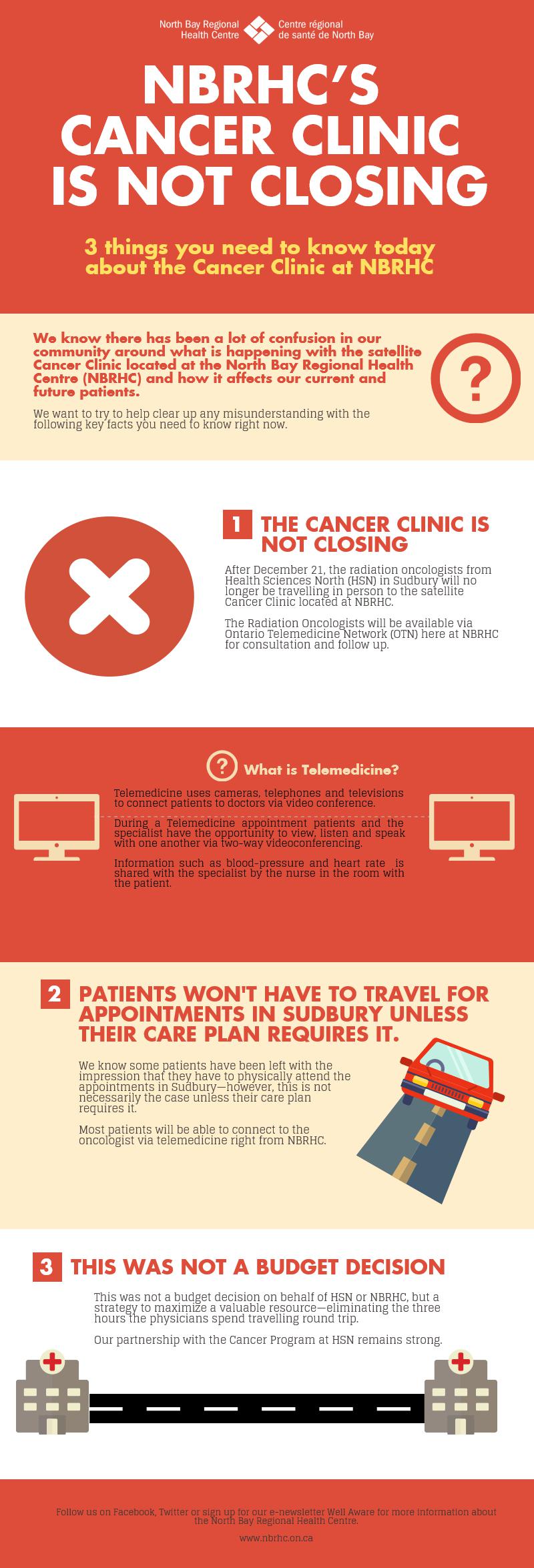Patients at the North Bay Regional Health Centre (NBRHC) and One Kids Place Children’s Treatment Centre are now benefitting from the exciting Smilezone transformations revealed at both organizations in a special unveiling held today.
Scott Bachly, Chair of the Smilezone Foundation says their organization is honoured to be a part of the NBRHC and One Kid’s Place Children’s Treatment Centre transformations. “This has been such a unique installation for us and we are overjoyed to have transformed six new Zones within the two facilities,” Bachly says.
Emma, a 16 year old patient at NBRHC’s Child and Adolescent Mental Health Unit (CAMHU), says the unit has a much more relaxing atmosphere since the renovations by Smilezone, and appreciates the outdoor theme. “Seeing all the different paintings of the outdoor stuff—like the camping and the waterfalls—it’s kind of brought outside inside. Things like the beanbag chairs and the paintings make it feel much more comfortable, and it’s much more ‘homey’,” Emma says. She says the renovations have helped ease anxieties. “In this place you can kind of feel like you’re trapped—but I feel like this really helps. It makes you feel more comfortable.”
NBRHC’s CAMHU was a plain and simple environment. With the installation of the Smilezones, hallways are now vibrant areas, brought to life with beautiful murals depicting our unique northern scenery. The kitchen, where children spend time doing activities and learning life skills, has been converted into a lively space with a campfire mural and giant whiteboard. The TV/media room incorporates an iPad station, beautiful cabinetry with a nature movie background. Inspiring wall graphics and a tactile station revamped the yoga, Wii and activity room.
|
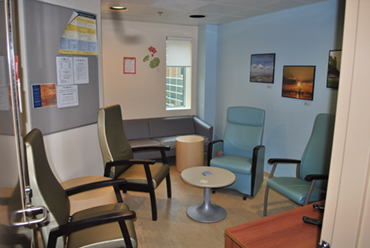
NBRHC Before
|
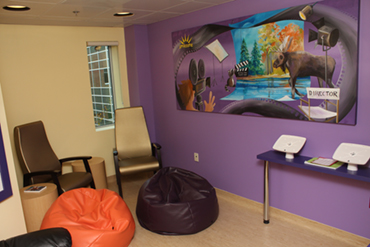
NBRHC After
|
“This facelift from Smilezone has transformed our Child and Adolescent Mental Health Unit into a bright, colourful and functional area for our youth to receive care and recover,” said Paul Heinrich, NBRHC President and CEO. “As our patients have told us, the colour and imagery is uplifting and soothing and we are grateful to the Smilezone Foundation for the improvement to our healing environment.” Heinrich says.
The two Smilezones at One Kids Place Children’s Treatment Centre are both incredible spaces to advance the treatment for kids.
With a wonderful outdoor theme, the Thomson Resource Room is vibrant and functional space for families to enjoy while waiting to see their therapist or pediatrician. Both families and therapists will enjoy the Smilezone for the combination between the exciting theme of the North Bay Battalion and the functionality of the new seating and cupboards for the Loan Equipment Program.
|
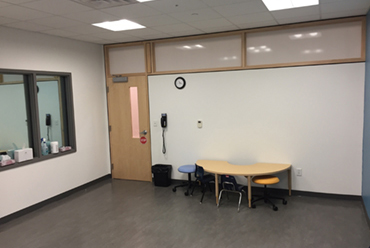
OKP Before
|
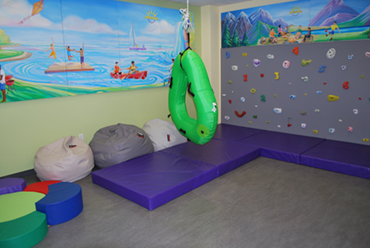
OKP After
|
The second Smilezone, a mountain themed therapy room, will be used for a wide range of therapy with the low
level traversing wall, the cushioned safe environment for kids working on the therapeutic swings or enjoying the soft play area while interacting and working with their therapist. This very functional space will truly help children and youth reach their full potential.
“One Kids Place is extremely thankful to the Smilezone Foundation for their generosity to the children, youth and families we serve,” Denis Filiatrault, Executive Director of One Kids Place says. “The two Smilezones are a true benefit to our therapists, the children, youth and families we serve and will definitely put a smile on the kids face for a long time to come.”
“We are grateful that Smilezone Foundation allowed the Battalion to be involved with the installation at One Kids Place,” said Battalion President Mike Griffin. “Over the last two seasons our players have been frequent visitors to the facility while assisting staff and our logo being permanently displayed makes our partnership even stronger.”
-30-
Contacts:
BACKGROUNDER:
SMILEZONE FOUNDATION
Smilezone Foundation is a registered charity committed to “putting smiles on children’s faces”. The charity, founded by Adam Graves and Scott Bachly in 2012, established the overarching mission of assisting children, and their families, who are facing difficult times and health challenges. Smilezone’s mission is to create, build and transform areas (“Zones”) in hospitals, private treatment and development centres, and children’s clinics, in order to improve the lives of children facing illness, disabilities, and physical and emotional obstacles—ultimately putting a smile on their faces. Visit smilezone.com for more information.
NORTH BAY REGIONAL HEALTH CENTRE
The North Bay Regional Health Centre (NBRHC) is a unique health care organization that provides acute care for North Bay and area, is the district referral centre for the Region and is the specialized mental health provider for Northeastern Ontario. For more information, visit www.nbrhc.on.ca.
CHILD AND ADOLESCENT MENTAL HEALTH UNIT
The Child and Adolescent Mental Health Unit at the North Bay Regional Health Centre provides crisis and specialized mental health services to children in Nipissing and Temiskaming Districts. Caring for over 120 children annually, the unit has six-beds. Working with community partners, such as North Bay Regional Child and Youth Mental Health Program, TheFamilyHelpNetwork.ca (HANDS) and the North Eastern Ontario Family and Children’s Services (NEOFACS), this new model of care brings together the expertise, skills and processes of each organization. Children and their families are now receiving better acute, long term and follow-up care, close to home.
NORTH BAY REGIONAL HEALTH CENTRE FOUNDATION
The NBRHC Foundation raises funds to ensure that your Health Centre can continue to expand hospital services, develop new programs, and bring leading-edge medical technology and treatment to the people of North Bay and regional communities. Through generous support of donors, the community helps ensure that the best health care will always be within reach.
The community has a long-standing history of supporting the Health Centre through the Foundation, which was founded in 1999. Successful campaigns include $18 million for the construction of NBRHC during the Caring for Generations campaign and $6.2 million for Seeing More Clearly: A campaign for an MRI and more.
ONE KIDS PLACE CHILDREN’S TREATMENT CENTRE
One Kids Place Children’s Treatment Centre (OKP) provides rehabilitation services to children and youth (up to the age of 19) and their families residing in the Districts of Muskoka, Nipissing and Parry Sound. OKP provides centre based and community based services in the areas of Physiotherapy, Occupational Therapy, Speech and Language Pathology, Social Work, Therapeutic Recreation and Behavior Therapy. Specialized services are provided across the region including Augmentative and Alternative Communication Program; Seating and Mobility Services; Developmental Clinic; Feeding and Swallowing Services and Orthopaedic Clinic. OKP is the lead agency for the Nipissing Timiskaming Preschool Speech and Language Program and the Muskoka Parry Sound Preschool Speech and Language Program. OKP provides services to the Infant Hearing Program and Blind Low Vision Program and is also the lead agency for the North East Applied Behaviour Analysis Program for children and youth with Autism Spectrum Disorder.
-end-
